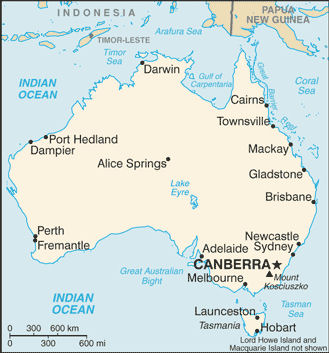Australia
2016

Prehistoric settlers arrived on the continent from Southeast Asia at least 40,000 years before the first Europeans began exploration in the 17th century. No formal territorial claims were made until 1770, when Capt. James COOK took possession of the east coast in the name of Great Britain (all of Australia was claimed as British territory in 1829 with the creation of the colony of Western Australia). Six colonies were created in the late 18th and 19th centuries; they federated and became the Commonwealth of Australia in 1901. The new country took advantage of its natural resources to rapidly develop agricultural and manufacturing industries and to make a major contribution to the Allied effort in World Wars I and II.
| Location: | 27 00 S, 133 00 E |
| Population: | 22,992,654 (July 2016 est.) |
| Area: |
total: 7,741,220 sq km
land: 7,682,300 sq km
water: 58,920 sq km
includes Lord Howe Island and Macquarie Island
|
| Climate: | generally arid to semiarid; temperate in south and east; tropical in north |
| Terrain: | mostly low plateau with deserts; fertile plain in southeast |
| Elevation: |
lowest pt: Lake Eyre -15 m
highest pt: Mount Kosciuszko 2,229 m
|
| Natural resources: | bauxite, coal, iron ore, copper, tin, gold, silver, uranium, nickel, tungsten, rare earth elements, mineral sands, lead, zinc, diamonds, natural gas, petroleum |